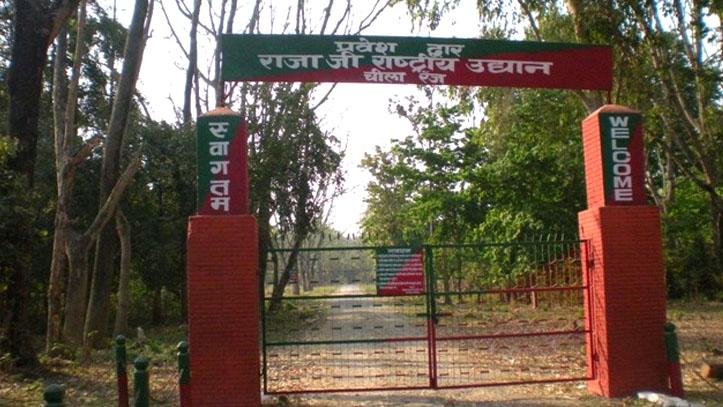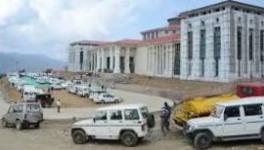Life After Lockdown: Next Maha Kumbh to Encroach on Rajaji

The scale is gargantuan. If the Ardh Kumbh Mela held in Allahabad (now Prayagraj) last year could gather between two and three crore pilgrims, the Maha Kumbh to be held in Haridwar next year is gearing to outshine the performance of the Yogi Adityanath government by assembling up to 20 crore pilgrims.
But how can Haridwar, a city enveloped by forests, accommodate such a vast surge of humanity? This is the vexing question presently facing Uttarakhand chief minister Trivendra Singh Rawat.
The answer to this problem was ingeniously provided by the Uttarakhand forest department, who would transfer 778 hectares of forest land to the Kumbh Mela Committee on a temporary basis. This land could be used to provide housing, toilets and parking facilities for the pilgrims.
The proposed forest land will be carved out from the Rajaji Tiger Reserve nestling in the Shivalik hills and the Narendra Nagar forest division which is home to tigers, elephants, leopards and a host of other rare animals. This land would be loaned to the Kumbh Mela Committee (KMC) from 1 September and would be in their safe keeping for the next nine months to be returned to the forest department once the Kumbh Mela ended on 31 May 2021.
The forest department would receive the sum of Rs 12.635 crore, as compensation for the loss of flora and fauna, given the massive amount of construction that would be required to house such large numbers of pilgrims.
A letter to this effect was reportedly written by DJK Sharma, the additional principal chief conservator of forests to the state principal secretary (forest) on 20 April, spelling out these details.
It seems ironical that such a letter should be written by a forest officer especially since such a proposal is in blatant violation of the Wildlife Protection Act, 1972 and the Forest Conservation Act, 1980 both of which stress on how forest zones are inviolate and that forest land cannot be diverted under any circumstances.
When this question was put before Jai Raj, the chief conservator of forests, Uttarakhand, he took pains to emphasise the temporary nature of this exercise. “Some temporary concessions have to be made for such a mega event which is of so much religious significance. We must not forget the forest land will be returned to us,” he said.
When asked what kind of precedence this would set especially since similar demands could be made for other tiger reserves as well, his response was, “We have put the matter up before the government. It is for them to take a decision. Everything will be done as per law.”
When repeatedly asked how a forester could come up with such a proposal given that the Indian Forest Service is committed to take care of forests, Jai Raj asked this writer to contact Rajiv Bhartari, principal chief conservator of forests, Uttarakhand.
Bhartari explained that the area being given to the KMC had been used earlier also to host the Kumbh Melas. “It will be used to provide a police picket and for purposes of medical aid,” he said.
“In any case, the land being given to the KMC comprises less than half a hectare but again the ultimate decision on this matter will be taken by the government of India,” said Bhartari.
Amit Verma, recently transferred as director of Rajaji Tiger Reserve, when queried about this proposal hastened to say, “I have not been privy to the meetings. But I would like to point out that (whatever the nature of the proposal) only 4.3 hectares of land from Rajaji will be handed over for the Kumbh Mela. This land will be given in two separate areas. One section is around the Mansa Devi temple complex which falls within the Rajaji reserve. The other is at Raiwala where the Kumbh Mela Committee needs to set up a police post and a medical camp,” Verma explained.
There is no uniformity on the size of the forest land to be allotted amongst the foresters. What is obvious is that no one is willing to speak out against the ruling dispensation. The KMC requires 1,000 hectares of land. They hope to get a part of this requirement from the Irrigation Department. The remaining will have to carved out of forest land.
By doing so, the forest department will only serve to exacerbate the problems presently facing the Rajaji reserve. The reserve has already been sliced into two parts by the National Highway 58 and the Haridwar-Dehradun railway line which has recently been electrified.
Work on the widening of the National Highway 58 connecting Delhi to Muzaffarnagar was expected to have been completed by 2013. This has not happened. The speed of work has hastened up in the last few months and the National Highway Authority of India insists work here will be completed before the advent of the Maha Kumbh.
But this delayed construction work has adversely impacted the free movement of animals especially for tigers and elephants. There are two tigresses on the western side of Rajaji which covers an area of around 50,000 has while there are 38 tigers to be found in the eastern part of the reserve which covers an area of 35,000 has.
Prasanna Patro, former director at Rajaji reserve, points out, “The tigresses on the western side do not cross over to the eastern side and vice versa. We are planning to reintroduce seven tigers in the western side. These will be brought from the Corbett landscape in order to increase their population.”
The fact that the western side of Rajaji has only two tigresses is troubling for other reasons as well. The Wildlife Institute of India (WII) had undertaken tiger trappings between 1996-99 and found there were 70 tigers in these forests. That figure has come down substantially in the last two decades as the size of the forest area has shrunk. The fact that they are only two left is troubling as this can affect the genetic pool of a species.
The other animal whose movement has been adversely affected is the elephant. Again, scientists with the WII have found that while male elephants manage to cross over from one side to another this is not the case with female elephants.
The increase in vehicular traffic in and around Rajaji has only served to further impair elephant movements.
A sizeable number of elephants have been killed due to the movement of trains within the Rajaji reserve. To prevent these accidents the Ministry of Environment and Forest, World Wildlife Fund, the Central Scientific Instruments Research Organisation and WII have got together with the railways to place seismic sensors along the railway track that extends within the reserve.
“These sensors are being placed along a 20 kilometre stretch. When an animal crosses in that area, their vibrations are picked up by the sensor which will immediately send a signal to the central sensor to be relayed to the Railway Station Master, the forest field staff and the train driver who can slow down or halt the train,” said Patro.
Patro however believes the MKC has asked for 113.39 has of forest land but will end up getting much less from the forest department.
“The land has to be given for a nine-month period because they need five months to do the preparatory work and then they will need it for another four months for the actual Kumbh Mela,’ said Patro.
“At least this time around, they have put in a request for the land. Earlier forest land used to be taken without even seeking permission,” Patro added.
Sharma, who had moved this proposal in the first place believes it is a step in the right direction. “It is better to propose mitigation measures in advance. There is no land around Haridwar except forest land, then where does the government expect to put up such large numbers of pilgrims,” he explained.
Sharma also believes that whatever the government order maybe, they will finally come around to accept his point of view. “Just wait and watch, this land from the tiger reserve will end up being used because there is no other land,” he says.
Tiger expert Valmiki Thapar who has worked with tigers for the last 45 years questions why reserve forest land should be given to the KMC.
“Not an inch of forest land should be handed over to any organisation. This is in clear violation of the Wildlife (Protection) Act 1972 and the Forest (Conservation) Act 1980. If the protectors are not going to protect the forests then who will,” asks an indignant Thapar.
Dehradun based activist Sanjeev Srivastava heading Citizens for Green Doon has launched an online petition highlighting how such a move will destroy the sensitive ecosystem of the Rajaji National Park which is home to many species of endangered wildlife, birds, reptiles and sensitive forests.
The petition reads, “These forests feed many rivers and water streams, maintain ground water reserves and provide oxygen. They also play an important role in mitigating pollution and maintaining environmental temperature.”
Srivastava warns that the fall out of any human activity in forests will result in indiscriminate felling of trees, tampering of the natural topography, disturbing underground water sources and causing pollution through human waste, plastic and other solid wastes.
The other matter of equal concern is the adverse impact the presence of 20 crore pilgrims will have on the Ganga river.
Vimal Bhai heading Matu Jan Sangathan said, “The Covid-19 lockdown has seen the rivers including the Ganga rejuvenate since toxic industrial effluents are no longer being dumped in it. The practise of pilgrims bathing in the river was also stopped. The presence of so many pilgrims will see large quantities of untreated sewage being dumped in the river raising coliform levels and polluting it once again,” said Vimal Bhai.
A study by Ritesh Joshi for the MoEF in 2010 on the impact the Kumbh Mela had on the elephant population living in the forests around Haridwar has already established the tremendous stress elephants suffered because of the presence of large numbers of human beings and a concomitant increase in vehicular traffic.
All these findings have little impact on our politicians. The Uttarakhand government has asked Finance Minister Nirmala Sitharaman for an allocation of Rs 5,000 crore for the Kumbh Mela. Obviously, Covid-19 has had little impact on preparations for this mega event, although it is clear as daylight that growing deforestation is the key reason for the spread of this pandemic.
The author is a freelance journalist. The views are personal
Get the latest reports & analysis with people's perspective on Protests, movements & deep analytical videos, discussions of the current affairs in your Telegram app. Subscribe to NewsClick's Telegram channel & get Real-Time updates on stories, as they get published on our website.
























